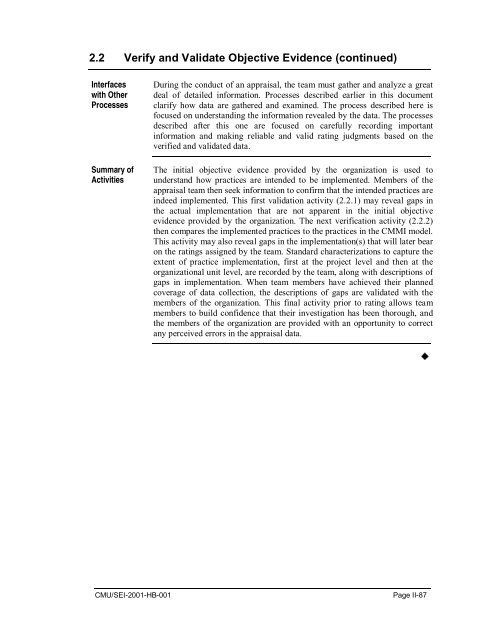Standard CMMI Appraisal Method for Process Improvement (SCAMPI)
Standard CMMI Appraisal Method for Process Improvement (SCAMPI)
Standard CMMI Appraisal Method for Process Improvement (SCAMPI)
You also want an ePaper? Increase the reach of your titles
YUMPU automatically turns print PDFs into web optimized ePapers that Google loves.
2.2 Verify and Validate Objective Evidence (continued)<br />
Interfaces<br />
with Other<br />
<strong>Process</strong>es<br />
Summary of<br />
Activities<br />
During the conduct of an appraisal, the team must gather and analyze a great<br />
deal of detailed in<strong>for</strong>mation. <strong>Process</strong>es described earlier in this document<br />
clarify how data are gathered and examined. The process described here is<br />
focused on understanding the in<strong>for</strong>mation revealed by the data. The processes<br />
described after this one are focused on carefully recording important<br />
in<strong>for</strong>mation and making reliable and valid rating judgments based on the<br />
verified and validated data.<br />
The initial objective evidence provided by the organization is used to<br />
understand how practices are intended to be implemented. Members of the<br />
appraisal team then seek in<strong>for</strong>mation to confirm that the intended practices are<br />
indeed implemented. This first validation activity (2.2.1) may reveal gaps in<br />
the actual implementation that are not apparent in the initial objective<br />
evidence provided by the organization. The next verification activity (2.2.2)<br />
then compares the implemented practices to the practices in the <strong>CMMI</strong> model.<br />
This activity may also reveal gaps in the implementation(s) that will later bear<br />
on the ratings assigned by the team. <strong>Standard</strong> characterizations to capture the<br />
extent of practice implementation, first at the project level and then at the<br />
organizational unit level, are recorded by the team, along with descriptions of<br />
gaps in implementation. When team members have achieved their planned<br />
coverage of data collection, the descriptions of gaps are validated with the<br />
members of the organization. This final activity prior to rating allows team<br />
members to build confidence that their investigation has been thorough, and<br />
the members of the organization are provided with an opportunity to correct<br />
any perceived errors in the appraisal data.<br />
<br />
CMU/SEI-2001-HB-001<br />
Page II-87
















